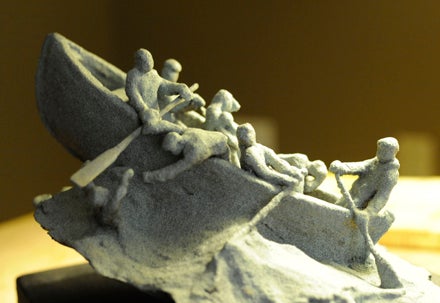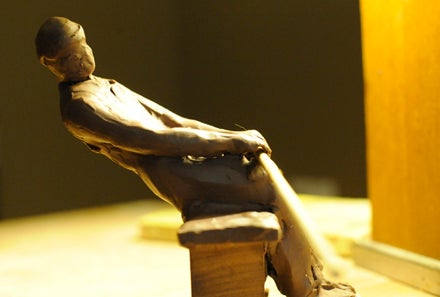Washington artist embarks on World War II memorial project
Published 6:57 pm Wednesday, June 24, 2015

VAIL STEWART RUMLEY | DAILY NEWS
MEMORIALIZED: Artist and Washington resident Douglas Alvord talks about his project, “The Brave Never Die,” that will memorialize the victims of the Battle of the Atlantic — the 1942 German U-boat attack on U.S. tankers and merchant ships carrying supplies to Britain — waged off the east coast. The 20-foot bronze sculpture will be installed in Hatteras Village in 2017.
In the years leading up to U.S. involvement in World War II, a one-sided battle was waged along the east coast. German U-boats patrolled the Atlantic — at night torpedoing and sinking ships that were no more than sitting ducks against a backdrop of lights along the shore. There were no government-mandated blackouts for those ships’ protection. Instead, most of the world never knew that the U.S., in 1942, was already at war.
Washington resident and artist Douglas Alvord is on a path to change that with a work of art memorializing the many Americans who died within sight of shore.
“Five thousand people died on the east coast; 1,700 of them died off the North Carolina coast. That 5,000 was more than (how many) died in Pearl Harbor, except they were civilians. Yet there was never a memorial to them. It’s time,” Alvord said.
Alvord has designed what will become a massive sculpture that captures victims’ harrowing fight for survival. “The Brave Never Die” is a proposed 20-foot long bronze sculpture of a lifeboat in high seas, depicting survivors in the immediate aftermath of an attack. Among the passengers: a man hunched in sorrow, a woman comforting a young child, another man struggling to reach a man overboard, while others man the oars. These were the unknown victims, Alvord said.

VAIL STEWART RUMLEY | DAILY NEWS
IN MINIATURE: The lifeboat holds figures in varying states of distress: a man hunched in sorrow, a woman comforting a child, another many reaching for the saving hand from the rough seas, along with those struggling to keep the small boat afloat.
“I want you to look right into the faces of these people and see them as people. … They were passengers on tankers or freighters. They were civilians or merchant marines,” Alvord said.
Alvord and noted historian Kevin Duffus came up with the idea for “The Brave Never Die” after the publication of Duffus’ book, “War Zone,” an account of the little known Battle of the Atlantic. The book chronicles the methodical sinking of tankers and merchant ships along the east coast, many of which were bound for Britain, carrying supplies to support that country’s ongoing war against the Germans.
Seventy-five years later, Alvord is drumming up support for the sculpture that will cost approximately half a million dollars to build. From the first, the plan was to install the memorial in a prominent place in Hatteras; however, gaining the support of the close-knit community on the Outer Banks was key, but an uncertainty, Alvord said.
“They knew it happened. They watched it happen,” Alvord said. “In order to do this properly, it has to come from the people out there.”
But support from the people of the Outer Banks has been overwhelmingly positive, as it has been from at least one local legislator — both the Hatteras Island Village Civic Association and Rep. Paul Tine are on board — and the project will be featured at the Hatteras Festival in September.

VAIL STEWART RUMLEY | DAILY NEWS
SKETCHES: Artist Douglas Alvord is currently making “clay sketches” of each figure in the lifeboat. The larger, more detailed sketches will inform the renderings in the 20-foot bronze sculpture.
“This is something that is very important to them. It’s never been memorialized or recognized,” Alvord said.
Right now, Alvord has created a model of the sculpture, and continues to work on “clay sketches,” larger, more detailed versions each piece of the lifeboat. He plans a fall launch of the project and hopes to have it installed in 2017, the 75th anniversary of the German attacks. Alvord will sculpt the full-size version of the work in Washington, but it will be cast in a foundry in Virginia that has cast a previous piece of Alvord’s.
For him, the issue is not about politics — whether or not the federal government should formally acknowledge the many American lives lost just off the east coast in 1942. It’s about the victims, the witnesses and the many members of the Lifesaving Service — the precursor to the U.S. Coast Guard — who risked their lives to save those lost casualties of war.





